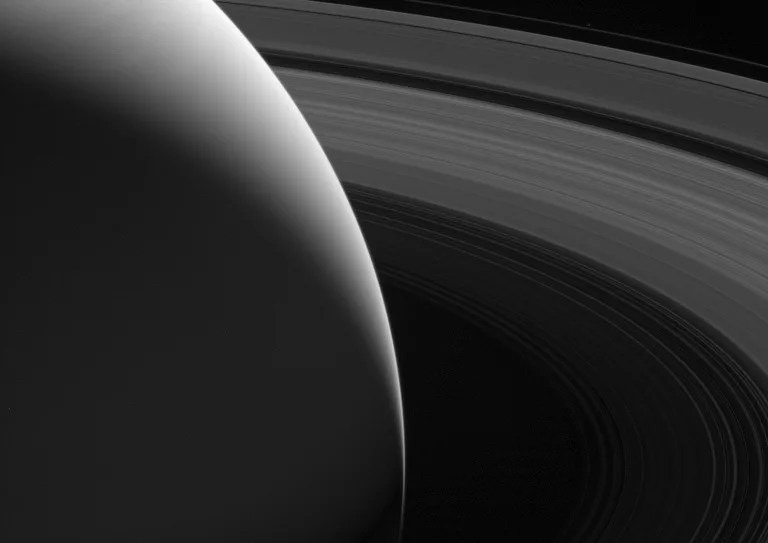5 min read

The Cassini-Huygens Program is now in Phase F (Closeout). The main task in this phase is to document the mission, and archive its data products for the decades of analysis to come. Space-exploration missions such as Cassini make the transition between one phase and another at points where key decisions are made by Program Management. Historically, Cassini's initial conceptual studies date back to 1982; the mission entered its formal Phase-A (Preliminary Analysis) work in 1987. Fast-forward, and 20 years ago this month Cassini-Huygens transitioned, at the moment of launch, into Phase E (Operations). Mission phases are further described here: https://go.nasa.gov/2xq64Y0.
During the first full month without a flight system, Cassini's engineers and scientists participated in academic workshops and conferences, and also connected with a variety of public audiences, as chronicled below.
In addition to those, this month roughly one thousand passers-by had a look at Saturn through a telescope, freely offered by some Cassini team members from the sidewalk. Many of the viewers reported that it was their first time seeing the ring-world via any sort of optics, rather than photographs. This sort of "surprise from the sidewalk" has been a regular feature for years on the busy, brightly lit streets in Old Town sections of Pasadena, and nearby Monrovia, California. Saturn is still well-placed in the evening sky for viewing in any telescope. Although it's lower and dimmer now, the rings remain wide-open towards Earth, making for a memorable sight.
Thursday, Sept. 28
Cassini’s Deputy Project Scientist gave a presentation on Cassini’s end of mission to the Cerro Coso Community College and the Owens Valley Radio Observatory in Bishop, California today. An audience of about 100 people were in attendance.
Tuesday, Oct. 3
A three-day Titan Surface Science meeting, attended by Cassini scientists, began today at the Massachusetts Institute of Technology.
Friday, Oct. 6
The Cassini Project Scientist was a guest on “All Space Considered” this evening at the Griffith Observatory.
Monday, Oct. 9
A two-day meeting of the Cassini Magnetometer team started today, at Imperial College, London. Science discussions focused on the recent Grand Finale data.
Tuesday, Oct. 10
This evening a celebration of the Cassini Mission was held at Imperial College. Speakers included the College president, the NASA Director of Planetary Science, the Director of Science for the European Space Agency, and the Principal Investigator for the Cassini Magnetometer team.
Wednesday, Oct. 11
With links to reports and videos of the mission's ending, today's news feature breaks down every moment of Cassini's final plunge into Saturn: /news/13126/reconstructing-cassinis-plunge-into-saturn.
Thursday, Oct. 12
Today the manager of Cassini's Navigation team talked about navigating the Cassini Grand Finale with JPL's Mission Design and Navigation Section at a Numerical Algorithms for Space Flight seminar.
Dione might be what a "normal" moon of Saturn should look like, but for those long, sinuous canyons visible in today's featured image: /resources/17801.
Sunday, Oct. 15
Today is the 20th anniversary of Cassini's launch from Cape Canaveral, Florida. On this day in 1997, the Program transitioned from Phase D (System Assembly, Integration, Test and Launch) into Phase E (Operations) based on the key decision point when launch was a "go" from the Program Manager.
Monday, Oct. 16
A five-day meeting of the American Astronomical Society's Division for Planetary Science kicked off today in Provo, Utah, with a Cassini press briefing and plenary session. Presentations over the course of the week covered Saturn, the rings, the magnetosphere, Titan, and the icy moons including active Enceladus. Some of the highlights are summarized in this feature article: /news/13127/fresh-findings-from-cassini.
Wednesday, Oct. 18
Structure and chemistry are seen at infrared wavelengths in clouds over the pole of Saturn's planet-like moon Titan. They are discussed in today's feature: /news/13128/nasa-team-finds-noxious-ice-cloud-on-saturns-moon-titan.
Thursday, Oct. 19
Cassini's Magnetometer science team met at the University of California, Los Angeles (UCLA) today, and then at Caltech on Friday, to continue discussions of magnetometer data returned from Cassini during the 22.5 proximal orbits.
Monday, Oct. 23
Cassini's Composite Infrared Spectrometer (CIRS) science team began a three-day meeting at the Goddard Space Flight Center in Greenbelt, Maryland today. Presentations included science highlights, calibration, archiving, and end-of-mission engineering and operations reports.
A beautiful image featured today shows strands of the C ring near Saturn. The narrow gap that Cassini navigated between the planet and the even closer D ring can be envisioned: /resources/17805.
Wednesday, Oct. 25
The Project Scientist gave a Distinguished Alumni Lecture on Cassini at Saturn today at UCLA.
Thursday, Oct. 26
Today, five engineers from Cassini's Spacecraft Operations team presented the Attitude Control Results from the Cassini Grand Finale. They showed some 300 people in the JPL audience how the spacecraft behaved, and how the attitude-control components performed, while the flight system skimmed through Saturn's upper atmosphere five times, and how it held on as long as possible during the final plunge.
Monday, Oct. 30
One of the ways Cassini's longevity has paid off has been the ability to observe the arrival of summer sunlight in Saturn's northern hemisphere: /resources/17806.
Wrap up:
The Cassini spacecraft ended its mission operations on Sept. 15, 2017. Cassini Significant Events reports are now being published near the beginning of each month. This page offers all the details of the Mission's ending: https://saturn.jpl.nasa.gov/mission/grand-finale/overview.







